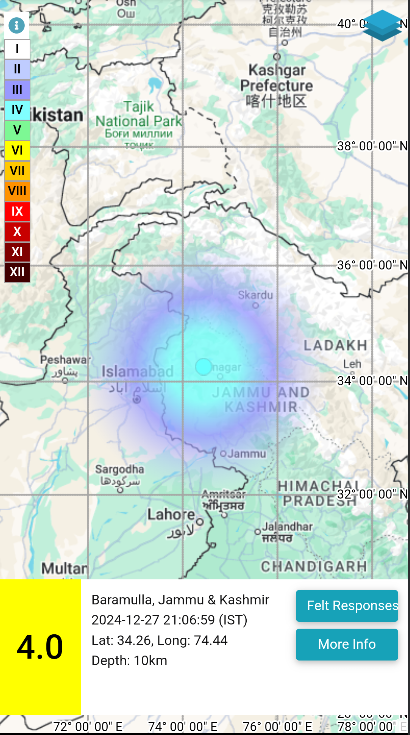Baramulla, Jammu and Kashmir, December 27.

A mild earthquake of 4.1 magnitude hit Jammu and Kashmir on Friday, December 27, as tremors were felt in Baramulla and the surrounding regions. According to NCS, the quake took place at 9:06 PM IST. The epicenter was at a latitude of 34.26° N and longitude of 74.44° E, at a shallow depth of 10 km.
The tremors were seen in Baramulla and its neighboring areas, giving residents brief moments of panic, but no damage or loss of life has been reported till date. NCS Tweeted on X (former Twitter) sharing the aftershocks: \”EQ of M: 4.0, On: 27/12/2024 21:06:59 IST, Lat: 34.26 N, Long: 74.44 E, Depth: 10 Km, Location: Baramulla, Jammu & Kashmir.
EQ of M: 4.0, On: 27/12/2024 21:06:59 IST, Lat: 34.26 N, Long: 74.44 E, Depth: 10 Km, Location: Baramulla, Jammu & Kashmir.
— National Center for Seismology (@NCS_Earthquake) December 27, 2024
For more information Download the BhooKamp App https://t.co/5gCOtjdtw0 @DrJitendraSingh @OfficeOfDrJS @Ravi_MoES @Dr_Mishra1966 @ndmaindia pic.twitter.com/TnjsxnwrjC
Recent Seismic Activity
This is the aftermath of a series of mild tremors in the region. Just yesterday, a 2.6 magnitude earthquake was reported in Haryana’s Sonipat, and last month, Jammu and Kashmir witnessed a more significant quake measuring 5.8 on the Richter scale, whose epicenter was in Afghanistan. These events show that the region is seismic sensitive as it is located close to the tectonic collision zone of the Indian and Eurasian plates.
Understanding Earthquakes Earthquakes occur due to the sudden liberation of energy in the lithosphere of the Earth, producing seismic waves that cause ground tremors. They are different in intensity, from unnoticeable tremors to shock waves that can shatter a whole city. Michigan Technological University claims that earthquakes with a: – 2.5 magnitude or lower are mostly not felt by people unless there is equipment to detect them.
Earthquake in Kashmir #Kashmir
— Bintisha 𝕏 (@Bintisha3) December 27, 2024
I hope and pray that everyone is safe #earthquake pic.twitter.com/etPB8vMW6J
- 2.5 to 5.4 magnitude are usually felt, but damage is not really extensive.
- 5.5 to 6.0 magnitude might cause slight damage in the buildings and structures.
With continued seismic activity in the region, the authorities request the public to stay alert and exercise caution so that the impact of the subsequent tremors can be minimized. Videos of the aftermath of the quake have been coming up online, reminding everyone of the vagaries of nature’s fury.
For more updates on seismic events and safety guidelines, stay tuned to local news channels and verified updates from the National Center for Seismology.
All to know about earthquakes
Tremors experienced on the Earth’s surface are earthquakes. They arise as a result of a sudden release of energy in the lithosphere. These seismic waves are different in intensity: some are so weak they don’t register, while others have such great power that destruction becomes widespread. Strong enough to topple buildings or to send objects and even people flying through the air, powerful earthquakes can break up critical infrastructure and totally ravage cities.
According to Michigan Technological University, earthquakes with a magnitude of 2.5 or less are usually not felt by humans but can be recorded by seismographs. Earthquakes with magnitudes between 2.5 and 5.4 are often felt but normally cause minor damage. Quakes measuring between 5.5 and 6.0 can cause moderate damage to buildings and other structures.
